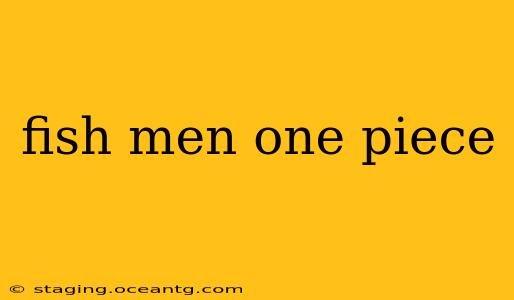The world of One Piece is rich with diverse races, and among the most intriguing are the Fish-Men. These humanoid creatures, inhabiting the underwater world, play a significant role in the story's overarching narrative. This comprehensive guide explores their history, unique abilities, societal structures, and the complexities of their relationship with humans.
What are Fish-Men and how are they different from Merfolk?
This is a common point of confusion for One Piece fans. While both Fish-Men and Merfolk live underwater, they are distinct races. Fish-Men are essentially humanoid fish, possessing the upper body of a human and the lower body of a fish. Merfolk, on the other hand, have the upper body of a fish and the lower body of a human. This fundamental difference leads to variations in their abilities and cultural perspectives.
What are the strengths and weaknesses of Fish-Men?
Fish-Men possess several distinct advantages due to their amphibious nature. Their strength is significantly amplified underwater, often surpassing that of humans. This is due to the increased water pressure, which enhances their musculature. Many Fish-Men also exhibit superior swimming skills and enhanced underwater endurance. However, their weaknesses are equally significant. Out of water, their strength is considerably diminished, and they are vulnerable to dehydration. Their gill structures also require them to be near water sources to survive.
Are all Fish-Men evil?
Absolutely not. While the story features antagonist Fish-Men, such as Arlong, it’s crucial to avoid generalizations. Fish-Men, like humans, exhibit a broad spectrum of personalities and moral compasses. Many are peaceful, kind, and strive for coexistence. The portrayal of Fish-Men in One Piece highlights the complexities of prejudice and societal structures rather than simply presenting them as inherently evil. Jinbe, a prominent Fish-Man, serves as a strong example of a benevolent and compassionate character, constantly striving for peace and justice.
What is Fish-Man Karate?
Fish-Man Karate is a powerful martial art unique to the Fish-Men. This fighting style leverages their enhanced strength and underwater capabilities. The force of their punches and kicks is dramatically increased underwater, making them formidable opponents. Different Fish-Men may specialize in various techniques, making it a diverse and adaptable fighting style. The most prominent example is Hyozou, who is incredibly skilled in Fish-Man Karate.
Why are Fish-Men discriminated against?
The discrimination faced by Fish-Men is a central theme throughout the One Piece narrative. This prejudice stems from a combination of factors, including physical differences, cultural misunderstandings, and historical power imbalances. Humans have historically dominated the surface world, often viewing Fish-Men with fear and suspicion. This has resulted in systemic oppression and ingrained biases that continue to fuel conflict and inequality.
How does the Fish-Man Island arc contribute to the overall One Piece story?
The Fish-Man Island arc is pivotal to understanding the broader narrative. It explores themes of prejudice, racism, and the pursuit of peace and equality. It introduces key characters, like Jinbe, and delves deeper into the complex political landscape of the underwater world. This arc serves as a turning point in the story, highlighting the interconnectedness of the surface and underwater worlds and the need for understanding and acceptance.
What is the future of Fish-Men in One Piece?
The future of Fish-Men in One Piece remains uncertain, yet full of potential. With ongoing exploration of the underwater world and the increasing involvement of characters like Jinbe, the narrative is poised to further explore their role in the greater story. Their struggle for equality and acceptance will undoubtedly continue to be a significant aspect of future events within the One Piece world.
This exploration of Fish-Men in One Piece offers a glimpse into the intricacies of this captivating race. Their struggles, abilities, and societal structures contribute significantly to the depth and complexity of the One Piece narrative, making them a vital element of the story's overall success.
